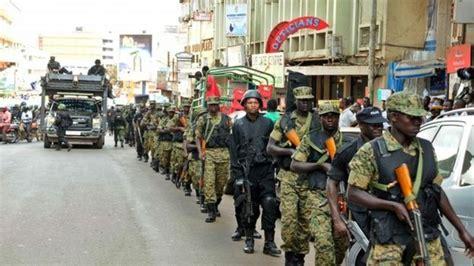
Uganda UK Terror Alert On Uganda
A terror warning issued by the U.K. has left Ugandan security on high alert. After two deadly attacks on Ugandan troops in Somalia and a rebel attack on a school in Kasese, it appears to be a moment of vulnerability for the country. The latter attack happened on the heels of a U.S. terror alert that was not apparently heeded to by authorities resulting into 42 deaths, 37 of whom were students.
On July 03, police chiefs inspected parts of downtown Kampala to assess the vigilance of those in public spaces. Brig. William Bainomugisha, the Commander of Military Police, and Stephen Tanui, the commander of Kampala Metropolitan Police, led officers on spot checks in the busy downtown area. The inspections have been daily since then with police canine units scouring Kikuubo and other populated areas in the Central Business District.
“Terrorists are very likely to try to carry out attacks in Uganda. Attacks could be indiscriminate or against foreign nationals or places frequented by foreign nationals,” the warning by the government of the U.K. read.
It added; “You should be vigilant at all times, especially in crowded areas and public places like hotels, transport hubs, restaurants and bars, and during major gatherings like sporting or religious events and when in close proximity to Government buildings or security installations such as police stations.”
Ugandan security has followed up with deployments at hotels, conference centers and prominent government offices.
The last terrorist bomb blast in November 2021 happened just in front of the Central Police Station and a stone’s throw away from the Parliament building. Six people were killed and 30 were injured in the attack that the government said ADF was responsible.
However a statement by Police spokesperson, Commissioner of Police Fred Enanga, while addressing the press raised eyebrows. “The alert doesn’t mention the type of terrorists, we have the known enemy, and whether these threats are imminent or not.”
Enanga went on to add that there are about 50,000 markets in Uganda implying the alert should have been more specific. Brig. Felix Kulayigye, the spokesperson of the UPDF, says Uganda is in touch with its regional counterparts in sharing intelligence and maintaining levels of alertness.
Uganda has a string of security agencies; Chieftaincy of Military Intelligence (CMI), Internal Security Organisation (ISO), External Security Organisation and Special Forces Command (SFC), an elite unit within the UPDF.
Since 2019, Uganda has also been recruiting and training Local Defence Units (LDUs) across the country as there were surges in violent crime in the city and countryside.
The U.S. State Department issued a travel advisory on June 12 four days before the Kasese attack saying “There remains a threat of terrorist attacks in Uganda and throughout out the region.” Although the travel advisory was laced with exaggerations, terror still truck anyway catching Ugandan authorities by surprise even as the terror alert was widely circulated on social media.
The ongoing troop drawdown by the African Union Transition Mission in Somalia (ATMIS) where the Ugandan army has been involved for the last sixteen years has also been cited as a moment of vulnerability. The UPDF and other troop contributing countries (TCCs) have been handing over forward operating bases (FOBs) to the Somali National Army which military officials say lacks the capacity to hold ground and shoulder its own country’s security challenges.
A military source in Somalia told The Independent on June 28 on a visit to Mogadishu that they were “expecting” an attack as the drawdown went on. The presence of Ugandan troops in Somalia is said to fuel the desire for jihadist attacks by the Al Shabaab who look at the UPDF as intruders.
A number of opposition politicians in Uganda have said the major reason why the Al Shabaab targets Uganda is because of Ugandan soldiers in the Horn of Africa nation who are not just peacekeepers in the mission but are actively involved in hunting down Al Shabaab militants.
However the terror alert comes at a time when the ADF, which the government held responsible for the attack in Kasese, has become a more sophisticated group.
A paper published in June titled Fatal Transaction: The Funding behind the Islamic State’s Central Africa Province by researchers at George Washington University, in the U.S. shed new light on how the ADF became a significant regional threat when it began receiving financial transfers from the Islamic State in 2017. The ADF has since rebranded to Islamic State’s Central Africa Province.
The paper notes that “the ADF not only overcame the loss of its previous funding streams precipitated by the arrest of its former leader, but also expanded its operations in East and Central Africa.”
The arrest of ADF leader Jamil Mukulu in 2015 from his hideout in Tanzania appears to have opened new windows for the group. He faces multiple charges of terrorism and murder. ISCAP has spread its wings to countries like Kenya, Tanzania, Somalia, Mozambique, South Africa and United Arab Emirates to coordinate its financing. Somalia and South Africa are mentioned as major financing hubs of ISCAP.
Testimony from ISCAP defectors and corresponding financial transfer receipts indicate that there are multiple Islamic State financial networks emanating out of Somalia and South Africa.
It added that money generated by the Islamic State in both Somalia and South Africa is therefore often pooled inside South Africa and subsequently laundered across East Africa through an intricate network that finances the Islamic State’s activities in the DRC, Uganda, Tanzania, and Mozambique. It cited the method of consolidation and regional distribution as a standard model for Islamic State financing globally.
Uganda has been a fertile recurring ground for ISCAP even when it was still known as ADF; a fringe shadowy element wrecking terror in Uganda. The paper’s insights present a major challenge to Uganda’s security apparatus who have treated the threat posed by ADF as a military one.





